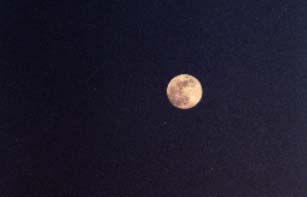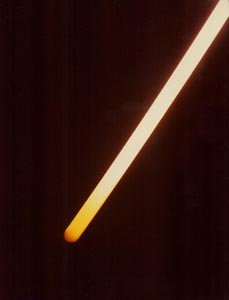
Perception is not always reality
Introduction
Here are three related perception activities using the full moon.
Activity 1
What do you remember?
What ordinary object held at arms length is
the same size as the moon: a dime, quarter, a pea something else?
Only after you write down your answer go to my suggested answer.
Moon Size answer
Of course as a scientist you must doubt my answer, and test it at the next opportunity.
Activity 2
How many full moon disks would just fill the bowl of the big dipper?
Only after you write down your answer, which is a correct answer
since it is the result you remember,
go to the measured answer. The Big Dipper
Answer.
Activity 3 The full moon illusion.

Why does the full moon look large as it rises and yet small overhead?
Measure the full moon as it rises or sets and when it is overhead. To do this, compare it with an object held at arms length.
Or take a photograph of the full moon as it rises and again when it is high in the sky. Use the same camera and lens. Then measure the diameter of the image of the moon on the photograph.(or use the photographs I have provided.)
In all cases you will find the moon is measured to be the same size. It is about the size of a pea or an aspirin tablet held at arms length, about 0.5 degree in angular diameter.
Measuring the photograph will give the same answer. The moon is the same diameter at the horizon and high in the sky.
So the apparent large size of the full moon as it rises is an illusion.
There are many theories as to why the moon appears larger on the horizon. One that I like is due to perception researcher Irwin Rock.
The perceived size of an object depends not only on the actual size of the object but also on its perceived distance. (See size constancy).
Our perception of the size of a distant person is automatically adjusted for perceived distance to alow us to get a better idea of the actual size of the person.
The moon always makes the same size image on our retina, however if we perceive the moon on the horizon as more distant than the moon overhead, then the more distant horizon moon must actually be larger to make the same size image. We then perceive the moon on the horizon as larger. In the same way we perceive a distant person as larger.

Other suggested theories, and a few tests.
One theory is that it appears larger because you can compare it to other items on the horizon. To test this contribution view the rising or setting full moon over a blank horizon like an Ocean or a lake. What do you see?
What happens to the perceived size of the moon when you look at the moon with your head down between and through your legs? (mooning the moon.)
What does atmospheric refraction do? The measured width of the moon remains the same but atmospheric refraction can reduce the vertical dimension of the moon making it appear squashed.
What about the effect of the reddish color? View the moon through a blue filter, and a red filter.
Here is a time lapse photograph which shows that the diameter of the rising full moon does not change as it rises.

Etc.
A student question.
Why are the sun and the moon the same angular size? Both are 0.5 degree in diameter.
Notice that the moon just covers the sun during a solar eclipse.
The moon and the sun are the same angular size by accident. To prove it, the moon's orbit is evolving. The moon used to be closer 300 Million years ago. It is now moving slowly away from the earth. So in the past its angular size was greater than 0.5 degrees and in the future it will be smaller and there will be no possibility of total solar eclipses.
How do you know that? From the record of the length of the month preserved in the growth rings of horn corals. They have day bands, month bands, and year bands. We believe the year length is very stable but that the day is lengthening as tidal drag slows the rotation of the earth, and that the month is changing (lengthening) also due to the drag of the tidal bulges.
Also we can see the evolution of the orbit today since we can measure the distance to the moon to better than a cm by bouncing lasers off the moon and measuring the round trip travel time.
How many moons does it take to fill the area of the sky defined by the bowl of the big dipper? The actual answer is 160 moons. The big dipper is approximately 6° x 6° the moon is 0.5° across so the approximate answer is
12 x 12 = 144
The size of the full moon answer.
The full moon is about the size of a pea or an aspirin tablet held at arms length.
|
Scientific Explorations with Paul Doherty |
|
22 May 2000 |